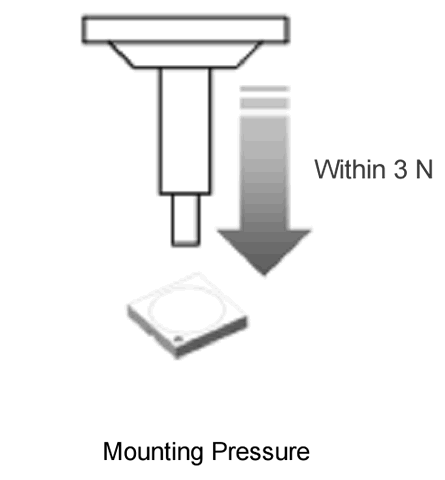This section expounds considerations while LEDs are placed on the circuit patterns after the solder paste printing. The LED placement requires the optimal shape/settings of a pick-and-place nozzle.
1. Shape of Pick-and-Place Nozzle
Nichia determines the optimal shape of a pick-and-place nozzle for each model through experiments. They recommend the optimal nozzle shape and size in the specifications as follows (for ref. NVSW119B). Please contact us when there is no description of the recommended nozzle in the specifications.
Recommended Conditions:
Using a nozzle designed for the LEDs is recommended (see Figure below.)
The nozzle must not have any direct contact with the encapsulating resin.
Direct contact with the encapsulating resin may result in internal disconnection causing the LED not to illuminate.
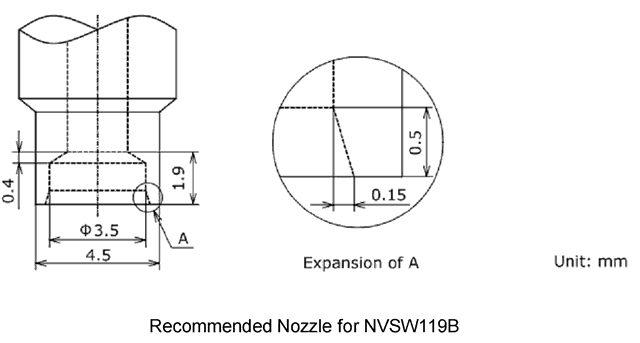
2. LED Collecting Method
Nichia’s Light Emitting Diode (LEDs) are placed in the optimal cavities of the emboss carrier tape and they need to be collected with an optimal nozzle accordingly.
There are two kinds of LED-collecting methods: insertion and hovering. The insertion type nozzle is inserted into each cavity and vacuums each LED, on the other hand, the hovering type nozzle vacuums LEDs above each cavity of the emboss carrier tape.
1) Insertion Type
The nozzle is inserted into each cavity and vacuums each LED, enabling stable LED-collection. Care should be taken not to insert the nozzle too deeply into the cavities; otherwise, the nozzle may damage LEDs. The inner surface of the nozzle should be finished by C-chamfering or R-chamfering, enabling each LED to be collected smoothly without being tilted.
2) Hovering Type
Nichia recommends that the hovering nozzle should be used for LEDs with lenses. The nozzle stops above each cavity and vacuums each LED.
If the insertion type nozzle is used for LEDs with lenses, it may touch and damage the lenses depending on the LEDs’ shape and the tolerance size of the LEDs and the nozzle. If you increase the clearance between the nozzle and the lens to avoid damage to the lenses, you will need a nozzle with a larger diameter, preventing the nozzle from being inserted into the cavities.
The insertion type nozzle may touch the lenses and the pressure is applied to the lenses accordingly, on the other hand, the hovering type nozzle may only apply vacuuming stress to the lenses. Therefore, LEDs are subject to less stress while collected with a hovering type of nozzle. Moreover, the hovering type of nozzle lasts longer because the inner wall of the nozzle can be thicker.
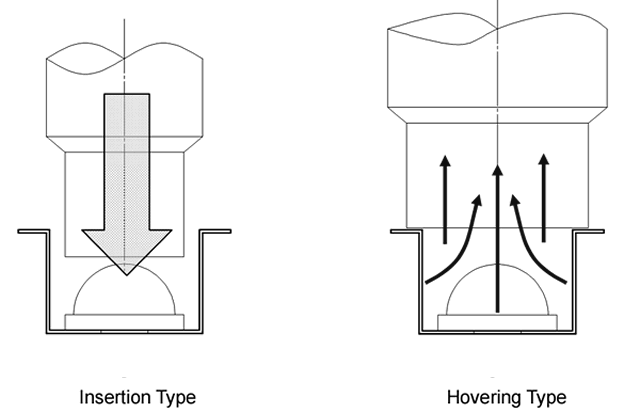
3. Optimization of Vacuuming Power
The vacuuming power should be optimized to prevent collecting failures depending on the LEDs’ shape/material; otherwise, LEDs may not be released from the nozzle but continue to be attached to it. The vacuuming power should be, in general, set from -40 to -80 Kpa.
4. SMT Feeders
Nichia recommends that electrical feeders should be used. Air feeders generate more vibration while feeding LEDs, resulting in LED-placement failure due to the LEDs’ tilt in their cavities.
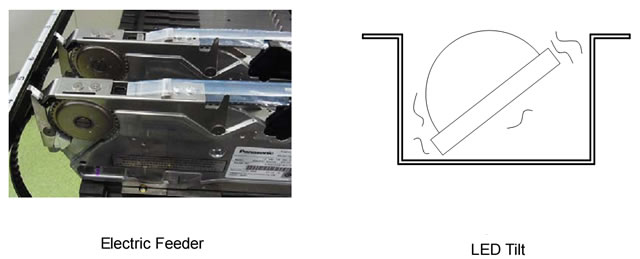
5. Peeling Point of Cover Tape
LEDs may be tilted in their cavities of the emboss carrier tape depending on the LEDs’ shape and the LED-placement machine. When the top cover tape is peeled far from the LED-collecting point, the LEDs tend to bounce in the space above them while vibrated, resulting in their major tilt.
Therefore, the top cover tape should be peeled just before the LED-collecting point. LEDs cannot bounce, thereby, preventing the LEDs from being tilted in the cavities.
The directions for cover tape peeling vary depending on the LED models. Please refer to the specifications of each model before use.
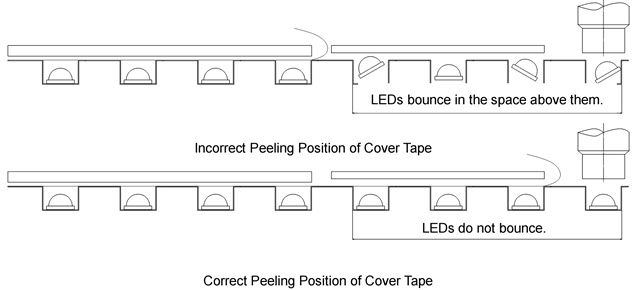
6. Feeding Speed
The LED-feeding speed needs to be optimized depending on the LED shape. Simple square LEDs can be picked up at high speed; on the other hand, LEDs with lenses cannot be picked up at high speed.
The center of gravity of LEDs with lenses is located higher. Moreover, the lenses tend to adhere to the top cover tape. When LEDs with lenses are fed and picked up at high speed, they may be tilted in their cavities or adhere to the cover tape and fall out of their cavities.
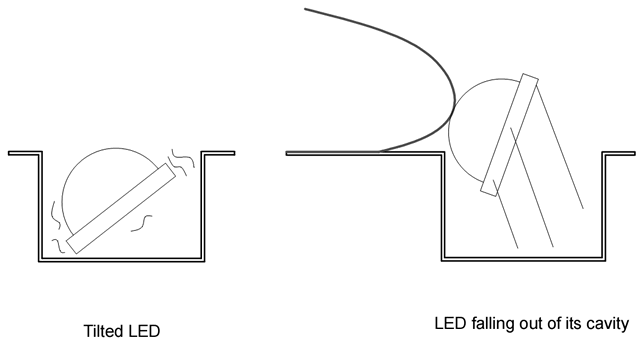
7. Mounting Pressure
Customers should take care when placing LEDs on the board in the mounting pressure. Insufficient pressure will lead to the lifting of LEDs or misalignment; on the other hand, too much pressure will result in solder ball formation. The amount of stress applied to LEDs is determined by the mounting pressure and the LED-feeding speed. As the amount of stress applied to LEDs is increased, their packages are susceptible to damage accordingly. Please set the mounting pressure within approx. 3 N, in general, to prevent LED packages from being damaged.
Please avoid any stress from being lenses are damaged by 3 N stress.
